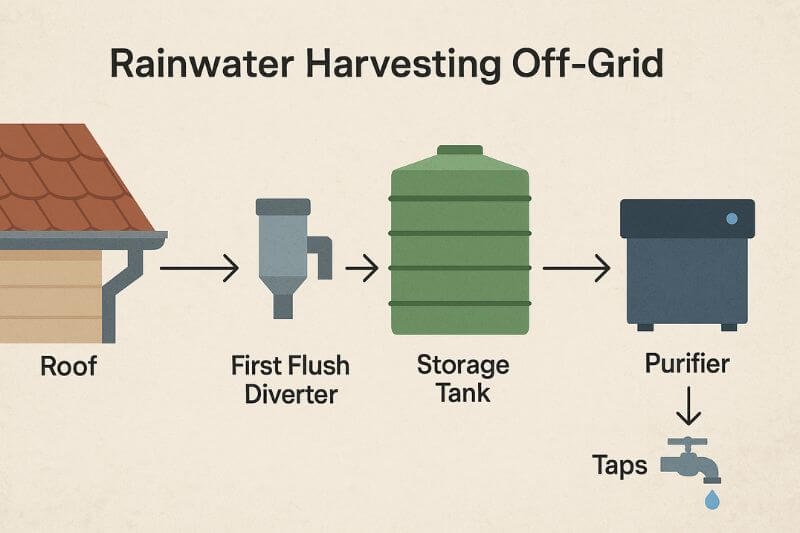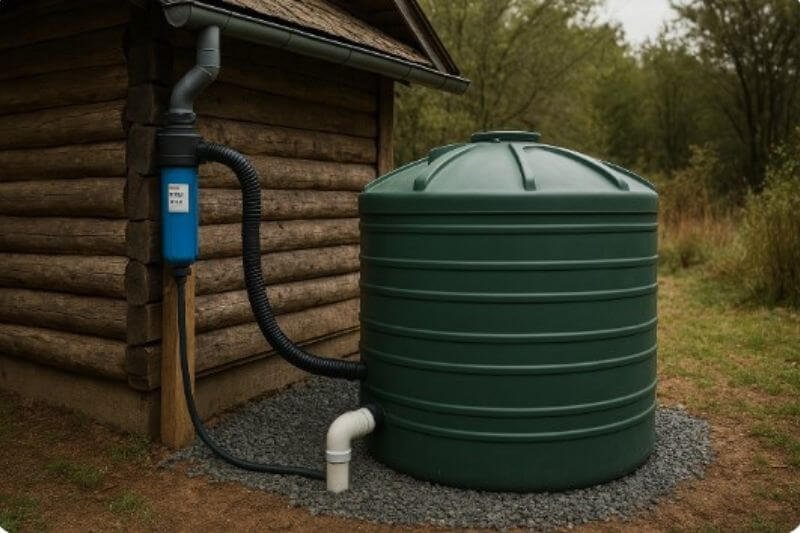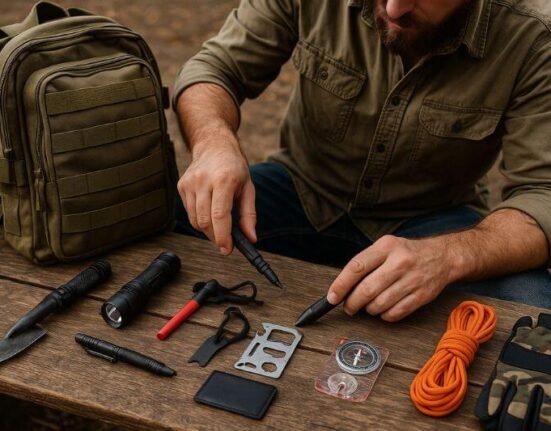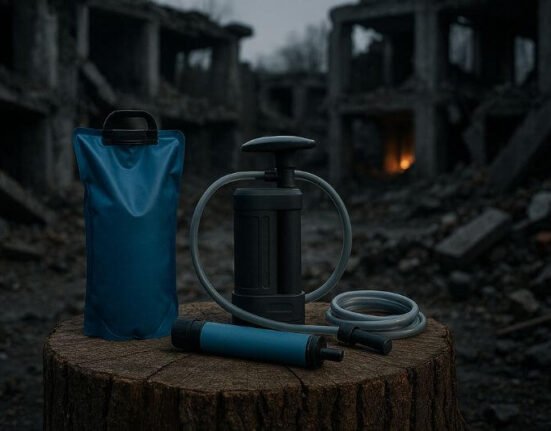Rainwater harvesting off-grid is the foundation of true water independence.
In an off-grid lifestyle, electricity may be optional — but water is non-negotiable. Whether you’re living in a remote cabin, prepping for a crisis, or building a resilient homestead, rainwater harvesting off-grid is one of the most accessible, sustainable, and essential systems you can set up.
In this guide, we’ll break down how to collect, store, and purify rainwater in a way that’s safe, efficient, and durable, using real-world setups that work in both rural and suburban environments.
🧩 The Essentials of Off-Grid Rainwater Harvesting
🌦️ Why Rainwater Harvesting Is Critical for Survival
Without reliable water access, your off-grid system is vulnerable. Municipal supplies can fail. Wells can dry. Rivers can get contaminated. But rainfall? If you’re prepared — it’s free, recurring, and renewable.
Key benefits:
- Total water autonomy
- Reduces strain on wells and aquifers
- No need to rely on grid-based utilities
- Can supply drinking, washing, irrigation, and livestock needs
According to the World Health Organization, a person needs at least 50 liters of clean water per day for drinking, hygiene, and cooking in survival contexts.
🏠 How Rainwater Harvesting Works Off the Grid
At its core, rainwater harvesting is a 3-stage system:
- Collection – Capturing water from a surface (usually rooftops)
- Storage – Storing in tanks or barrels
- Treatment – Filtering and purifying for safe use
📦 Example Diagram:

Each component plays a role in keeping the water usable and safe.
🏗️ Collecting Rainwater: Roofs, Gutters, and Diverters
The roof is your first tool. The bigger and cleaner it is, the more you collect.
| Material | Water Quality | Efficiency |
|---|---|---|
| Metal (zinc, tin) | Excellent | ✅✅✅ |
| Asphalt shingles | Moderate | ✅✅ |
| Thatched/wood | Poor | ❌ |
Pro tip: Use leaf screens and gutter guards to reduce debris early.
Then, install a first flush diverter — a simple mechanism that redirects the first few gallons (which usually carry dirt, bird droppings, and roof debris) away from your tank.
🛢️ Choosing the Right Storage Tank
Storage is where many off-grid setups fail. Too small, and you’ll run dry. Too exposed, and bacteria or algae can grow.
Key features to look for:
- Opaque (no sunlight = no algae)
- Food-grade materials (especially for drinking use)
- Freeze-resistant or buried (for cold climates)
- Overflow and screened ventilation system
| Capacity (gallons) | Use Case |
|---|---|
| 55–100 | Garden, emergency wash station |
| 200–500 | Off-grid RV, tiny home |
| 1000+ | Full homestead, livestock, backup |
🧠 Rule of thumb: 1 inch of rain on 1000 sq. ft. roof = ~600 gallons.
🚰 Water Purification Basics
Rainwater is relatively clean — but it still picks up bird droppings, insects, dust, and roof residues. It must be filtered and treated before human consumption.
Filtration stages:
- Sediment filter (removes dirt)
- Carbon filter (removes smell, taste, chemicals)
- UV light or boiling (kills microbes)
- Optional: Ceramic or Berkey gravity filters (great for off-grid)
⛔ NEVER drink raw rainwater — even if it “looks clean.” E. coli, Giardia, and Cryptosporidium can all survive in it.
According to the CDC, all collected rainwater for human use must be filtered, disinfected, and stored correctly to prevent illness.
🧮 Estimating Water Needs Off-Grid
Your system size depends on:
- Climate (rainfall frequency)
- Number of users
- Daily water usage
Example (2 people):
- Drinking: 3 gal/day
- Washing: 10 gal/day
- Cooking: 2 gal/day
- Garden: 10 gal/day
➡️ Total: ~25 gallons/day
For a dry month: 25 x 30 = 750 gallons
That’s at least 2 full 330-gallon IBC tanks per month of independence.
🔍 Common Mistakes to Avoid
- No first flush: Your water will always taste off or clog filters fast.
- Transparent tanks: Algae will grow rapidly with sun exposure.
- Over-reliance on one source: Always have a backup (well, creek, or barrel reserve).
- Improper gutter slope: Water must flow smoothly to downspouts — avoid stagnation.
🛠️ Building and Installing an Off-Grid Rainwater Harvesting System
🧰 Step-by-Step: Setting Up Your Rainwater Harvesting Off-Grid
Whether you’re collecting a few gallons for gardening or storing enough for full survival independence, the process follows the same core principles.
🔨 Step 1: Select and Prepare Your Collection Surface
Your roof is the primary capture zone. Make sure it’s:
- In good repair (no rust or leaking seams)
- Free from overhanging branches (reduces leaf buildup)
- Cleaned at least seasonally
If you don’t have a roof, you can build a poly tarp catchment system or create a sloped “rain tent” with PVC and tarp for temporary setups.
🪜 Step 2: Install Gutters and Downspouts
Gutters should have:
- A slight slope (1–2% incline) toward the downspout
- Leaf guards or screens
- A solid mounting base (metal brackets every 2–3 feet)
⚠️ Common mistake: Gutters too flat = pooling and overflow.
💦 Step 3: Add a First Flush Diverter
This is non-negotiable in survival-grade systems. It prevents the dirtiest water from reaching your tank.
You can buy prebuilt diverters, or build one with:
- A vertical pipe with a ball valve
- A drip outlet or sponge filter
- A ball that floats up after initial flush
🧪 Add a screen at the top to catch large debris.
🛢️ Step 4: Connect to Storage Tanks
Position tanks on a stable, level base (gravel + pavers or a concrete pad).
Plumbing tips:
- Use food-grade hoses or PVC
- Seal all connections with plumber’s tape
- Add a bottom spigot for easy access
- Install an overflow pipe with a screen to keep bugs and debris out
📏 Position tanks at least 12 inches above ground level for gravity-fed systems.
💧 Step 5: Install a Purification System
Depending on usage (drinking vs irrigation), choose one of these setups:
| Use Case | Filtration Required |
|---|---|
| Garden use | Sediment filter (optional) |
| Shower/washing | Sediment + carbon filter |
| Drinking | Sediment + carbon + UV or ceramic |
Gravity-fed systems with Berkey or ceramic filters are ideal for off-grid use, since they require no electricity and have replaceable cartridges.
🏕️ DIY vs. Prebuilt Kits: What’s Better Off-Grid?
🛠️ DIY Benefits:
- Cheaper (can build basic system for $100–300)
- Flexible to your space
- Teaches vital survival skills
📦 Prebuilt Kit Benefits:
- Plug-and-play (easy to install)
- Professionally sized and sealed
- Often includes filters + diverters
✅ Best for beginners: Hybrid approach — DIY storage + prebuilt diverter + commercial filter system.
🧪 Best Materials for Off-Grid Durability
| Component | Recommended Material | Notes |
|---|---|---|
| Gutter | Aluminum or galvanized steel | Lightweight and weather-resistant |
| Piping | PVC (UV resistant) or PEX | Avoid garden hoses — often not food-safe |
| Storage tanks | Food-grade polyethylene (HDPE) | Opaque colors like green or black |
| Filters | Ceramic, carbon block, or UV | Replaceable, low-maintenance |
FEMA advises using NSF 61-certified tanks and pipes for potable water to avoid chemical leaching.
🧭 Real-World Survival Example
The Cartwright Family – Northern Arizona
They live 100% off-grid on 5 acres of dry land. With only 12 inches of annual rainfall, they manage to collect and store over 8,000 gallons a year using:
- 1000 sq. ft. metal roof
- 4 x 275-gallon IBC tanks
- Leaf filters + first flush diverter
- Berkey filter for drinking water
- Extra backup from greywater collection
Lesson learned: “We underestimated how much water cleaning and gardening actually uses. You need double the storage you think you need.”
❌ Common Pitfalls (and How to Avoid Them)
- Tank overflow flooding the foundation → Always redirect overflow away from structures
- Filter clogging after one storm → Pre-filter screens are essential
- Mosquito breeding inside tanks → Use fine mesh screens + close all openings
- Plastic barrels breaking in winter → Elevate or bury tanks to prevent freezing
🔗 Useful Internal Resources
- Off-Grid Cabin Construction Guide
- Long-Term Survival Supplies List
- Bug Out Water Systems for Mobile Survival
- Off-Grid Solar Power Basics
🌾 Long-Term Water Security and Advanced Rainwater Strategies
🔁 Long-Term Maintenance for Rainwater Harvesting Off-Grid
Collecting rainwater is only the beginning. Ensuring it’s safe and accessible year-round requires routine care and seasonal adaptations.
🧽 Monthly Maintenance Tasks
- ✅ Clear gutters of leaves and debris
- ✅ Check and clean leaf filters and diverters
- ✅ Scrub tank lids and ventilation screens
- ✅ Flush out sediment from the tank base (if no internal filter)
“A dirty tank can turn your rainwater from a survival asset into a microbial hazard.” – CDC Safe Water Guidelines, 2023
❄️ Winterization Tips
In cold climates, freezing can damage tanks and pipes.
How to protect your system:
- Bury pipes below frost line (if applicable)
- Wrap exposed valves or tanks with insulation
- Use floating heaters in large tanks or heat tape on pipes
- Install bypass valves to drain non-essential lines in winter
💡 Many off-gridders switch to stored water or snow melt during deep freeze months.
🔥 Drought and Water Scarcity Strategies
Rain doesn’t always come when you need it. Drought-proof your system with:
- Multiple collection surfaces (greenhouse roofs, sheds, porches)
- Backup tanks (even old bathtubs or barrels)
- Greywater reuse for toilets and irrigation
- Water rationing plans (prioritize hygiene + hydration)
📦 Bonus Tip: Keep 1–2 weeks’ emergency supply in jerry cans, stored in cool, dark places.
🧠 Greywater Integration
Greywater (from showers, sinks, and laundry) can safely be reused for:
- Flushing toilets
- Garden watering
- Tree irrigation
How to do it safely:
- Use biodegradable soap
- Avoid reuse from kitchen sinks (due to grease/bacteria)
- Filter greywater before storage if reusing after 24h
⛔ NEVER mix greywater and blackwater (toilets).
🧪 Testing and Treating Water Over Time
Water that sits too long becomes unsafe. Rainwater can stagnate, grow algae, or breed bacteria without proper treatment.
🔬 Regular Water Testing
Every 3–6 months, test for:
- pH level
- Total dissolved solids (TDS)
- Presence of E. coli or coliforms
💡 Use affordable home test kits or send samples to a lab annually if drinking the water daily.
💧 Ongoing Treatment Methods
| Method | Effective Against | Power Needed | Best For |
|---|---|---|---|
| Boiling | Bacteria, viruses | Yes (or fire) | Emergencies |
| UV purification | Microbes | Yes | Everyday drinking water |
| Berkey/Ceramic | Sediment + microbes | No | Off-grid filtration |
| Chlorination | Microbes (temporary fix) | No | Storage tanks & field use |
According to the WHO, water must be treated after storage — not just before.
❓ Frequently Asked Questions (FAQ) – Rainwater Harvesting Off-Grid
Q: Is rainwater harvesting legal everywhere in the U.S.?
No — rainwater harvesting is not universally permitted, and laws vary significantly by state, municipality, and even by water district.
In general:
- ✅ Most rural states like Oregon, Texas, and Alaska actively encourage rainwater harvesting, especially for agriculture and resilience.
- ⚠️ Colorado, historically one of the most restrictive states, now allows limited collection (110 gallons max) for residential use — but only with specific conditions.
- 🛑 Some municipalities, especially in drought-prone California or parts of the Southwest, restrict large-scale rainwater systems due to concerns about watershed depletion or mosquito breeding.
These laws are often based on outdated water rights frameworks — some dating back to 1800s “first in time, first in right” laws — which assume all rainfall belongs to the river basin.
✅ Best practice:
Always check your local ordinances, especially if:
- You plan to collect more than 1000 gallons
- You’re in a homeowner’s association (HOA)
- You’re selling filtered rainwater or using it commercially
💡 Helpful resource: National Conference of State Legislatures – Rainwater Harvesting Laws
Q: Can I drink rainwater directly from my roof?
Absolutely not — and this is a common misconception in survivalist circles.
Even if your rooftop “looks” clean, it can harbor:
- Bird droppings (salmonella, E. coli)
- Mold spores and pollen
- Dust, lead particles, or soot from air pollution
- Asphalt or tar residue from roofing shingles
- Microplastics or chemical coatings (especially on newer roofs)
🧪 Rainwater is not naturally sterile — and once it contacts any surface, it becomes biologically active.
To make rainwater safe for drinking, follow this multi-step process:
- First flush diverter – discard the first few gallons after each rain
- Sediment filtration – to remove physical debris and particles
- Activated carbon filtration – to eliminate odors, taste, VOCs
- Disinfection – via boiling, UV treatment, or Berkey-style ceramic filters
“Roof-collected water should never be consumed untreated. Pathogens like Cryptosporidium and Giardia can survive for weeks in stored water.” — CDC Rainwater Guidelines, 2022
Q: What if I live in a desert or dry climate — does rainwater harvesting still work?
Yes — but it requires smarter planning and more aggressive capture techniques.
In arid regions like the Southwest U.S., parts of North Africa, or the Australian outback, rainfall may only occur a few times a year — but when it does, it’s often in large bursts. Capturing and storing every drop is key.
💡 Strategies for dry climates:
- Use large roof surface areas — metal roofs are ideal for hot, dry zones.
- Maximize first flush efficiency — even short showers can yield hundreds of gallons.
- Store water underground or in shaded tanks — prevents evaporation and reduces algae risk.
- Install overflow tanks or modular barrel systems — increases capacity without wasted water.
- Integrate swales and earthworks — to direct runoff into catchment zones for gardens or trees.
🌵 Bonus: In some coastal deserts (e.g., Chile’s Atacama), fog harvesting is a viable option. Using fine mesh “fog nets,” you can capture moisture from morning fog and condense it into usable water — hundreds of liters per day in some areas.
Q: Is algae in my tank dangerous? What can I do about it?
Yes — algae is a sign that your system is being exposed to sunlight, and it can compromise the safety and usability of your stored water.
Why it’s dangerous:
- Algae can produce toxins (cyanobacteria)
- It affects taste, odor, and color
- It clogs filters and pipes
- It indicates organic contamination and stagnation
Prevention strategies:
- Use opaque tanks (green, black, or dark blue) — never transparent or translucent
- Seal all tank openings, including vents and overflows, with mesh screens
- Flush out the bottom of the tank every 3–6 months to remove sediment where algae may grow
- Consider using a UV sterilizer inline after storage if algae issues persist
- Place your tank in a shaded or partially buried area
If you already have algae:
- Drain the tank
- Clean the interior walls with a mild bleach solution or vinegar (rinse thoroughly)
- Replace or clean all filters in the system
“Light is algae’s trigger. Eliminate light = eliminate algae.” — Survivor Water Tech Field Manual, 2023
✅ Conclusion: Water is Survival — Make It Resilient
Rainwater harvesting off-grid is more than just smart — it’s a lifeline. With the right setup, you can:
- Stay hydrated when municipal lines fail
- Keep crops alive during droughts
- Power your entire off-grid life, sustainably
Whether you’re prepping for total collapse or just trying to live cleaner and freer, water independence starts with your roof.
Set it up right. Maintain it. And you’ll never depend on fragile systems again.















